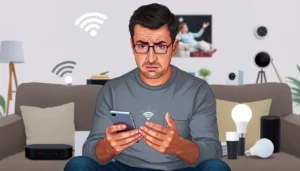Table of Contents
ToggleIn a world where your toaster might be plotting against you, smart home privacy protection has never been more crucial. With devices that listen, watch, and sometimes even talk back, ensuring your personal space remains just that—personal—is a top priority. Imagine your fridge spilling secrets about your midnight snack habits to the internet. Yikes!
As technology evolves, so do the risks. From smart speakers to security cameras, these gadgets can make life easier, but they can also turn your home into a digital fishbowl. Understanding how to safeguard your privacy is essential for enjoying the benefits of a smart home without feeling like you’re hosting an uninvited audience. Let’s dive into the world of smart home privacy protection and explore how to keep those pesky intruders at bay while still enjoying the perks of modern living.
Understanding Smart Home Privacy Protection
Smart home privacy protection revolves around safeguarding personal data and maintaining control over connected devices. Prioritizing privacy is essential to enjoy the benefits of smart technologies without exposing sensitive information.
Importance of Privacy in Smart Homes
Privacy in smart homes ensures data security and personal safety. Smart devices, like cameras and voice assistants, gather extensive information. Protecting this data builds trust between users and manufacturers. Individuals must recognize that compromised privacy can lead to identity theft or unauthorized access to home networks. Ensuring robust privacy measures allows users to take full advantage of smart home conveniences while minimizing risks. Everyone benefits when privacy protection becomes a priority in smart technology.
Common Privacy Risks
Smart home devices pose several common privacy risks. Data interception by hackers remains a significant threat. Malicious actors can exploit weak passwords or outdated software to gain access. Additionally, many smart devices collect data continuously, leading to potential misuse of personal information. Furthermore, cloud storage solutions often raise concerns about data breach vulnerabilities. Unsecured networks can also invite unauthorized users into home environments. Addressing these risks calls for increased awareness and proactive measures to protect privacy in smart homes.
Key Features of Smart Home Privacy Protection
Smart home privacy protection encompasses various essential features that enhance security and keep user information safe. Two of the most critical features include data encryption and user authentication.
Data Encryption
Data encryption plays a vital role in safeguarding user information. It converts sensitive data into encoded formats, rendering it unreadable to unauthorized individuals. Smart home devices utilize encryption protocols, such as AES (Advanced Encryption Standard), to ensure secure communication between devices and servers. Effective encryption protects against data interception during transfer, significantly reducing the risk of unauthorized access. Individuals should always seek devices that offer strong encryption to enhance their protection. Regular updates to encryption standards further enhance the safety of personal information stored on smart devices.
User Authentication
User authentication establishes control over who accesses smart home devices. Strong authentication mechanisms, like two-factor authentication (2FA), add an additional layer of security. Implementing 2FA requires users to provide multiple verification forms, such as a password and a code sent to a mobile device. Smart home systems should support user-defined security measures to strengthen access controls. Relying solely on weak passwords can leave systems vulnerable. Users must prioritize strong authentication strategies to significantly reduce the chances of unauthorized access to their smart home networks.
Best Practices for Smart Home Privacy Protection
Implementing smart home privacy protection requires strategic actions. Adopting best practices helps secure personal information and enhances safety.
Regular Software Updates
Regularly updating software on smart devices ensures that users benefit from the latest security enhancements. Device manufacturers often release updates that address vulnerabilities and improve performance. Keeping firmware current protects against threats such as malware and unauthorized access. Users who enable automatic updates can minimize risks by ensuring devices remain up-to-date without manual intervention. Checking for updates every month provides an additional layer of security and peace of mind.
Device Settings Management
Managing device settings plays a crucial role in protecting privacy. Users should review and customize default settings to minimize data sharing and increase security measures. Disabling unnecessary features, such as cameras or microphones, reduces potential exposure to unauthorized access. Configuring privacy settings and adjusting permissions limits the amount of data collected by devices. Regularly checking these settings can enhance overall privacy and provide users with better control over their personal information and home environment.
Legal Aspects of Smart Home Privacy
Legal frameworks governing smart home privacy are crucial for ensuring consumer protection. Strong regulations help individuals understand their rights and responsibilities regarding personal data.
Data Protection Regulations
Data protection regulations, such as the General Data Protection Regulation (GDPR) and the California Consumer Privacy Act (CCPA), set strict guidelines for data collection and usage. These laws require companies to obtain clear consent from consumers before gathering personal information. Violations can result in substantial fines and penalties, encouraging businesses to prioritize user privacy. Manufacturers must ensure their smart home devices comply with these regulations to avoid legal repercussions. Regular audits are essential for organizations to affirm compliance and build consumer trust.
Consumer Rights
Consumers possess specific rights concerning their personal data in the context of smart home devices. Rights include accessing, correcting, and deleting personal information stored by companies. Individuals can request transparency about how their data is used, allowing for informed choices. In many instances, consumers also have the right to opt out of data collection or marketing communications. Companies must provide mechanisms for users to exercise these rights efficiently. Awareness of these rights empowers consumers to safeguard their privacy while engaging with smart technologies.
Smart home privacy protection is no longer optional; it’s essential for anyone embracing modern technology. By prioritizing data encryption and robust user authentication, individuals can significantly enhance their security. Regular software updates and customized device settings further empower users to maintain control over their personal information.
Understanding legal frameworks like GDPR and CCPA helps consumers navigate their rights regarding data privacy. With proactive measures and informed choices, users can enjoy the conveniences of smart homes without compromising their safety or privacy. As the smart home landscape continues to evolve, staying vigilant and informed will be key to protecting personal data in an increasingly interconnected world.







